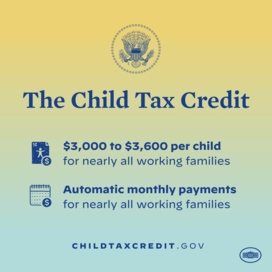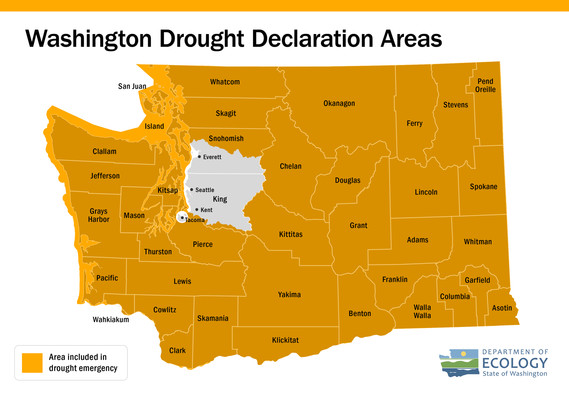Happy Fantastic Friday!
The Child Tax Credit: Relief for Families

An expanded Child Tax Credit included in the American Rescue Plan is now available for most families! For every child under 6, families will receive $3,600/yr and for every child 6-17, they will receive $3,000/yr, sent out automatically in monthly installments. Couples earning under $150,000 or single parents earning up to $112,500 qualify! This is money sent directly to families to help cover expenses like rent, diapers, food, childcare and everything in between. If you filed tax returns for 2019 or 2020, or if you signed up to receive a stimulus check from the IRS, you will get this tax relief automatically. File with the IRS on their Child Tax Credit Non-filer Sign-up Tool. Do not delay in signing up. There is no deadline for signing up but payments are not retroactive. You can also find the sign up tool en Español. This money will help reduce child poverty and reach 1.4 million kids in our state, so I’m doing what I can to help get the word out about the Child Tax Credit! I’m hopeful that you, and others in our state, will forward this email and talk about this with your friends and neighbors because you never know who may really need this relief and not know that they’re eligible. Additionally, some families who typically owe taxes may want to opt out of advance payments this year, you can opt out here. |
Washington State is in a Drought
A historically dry spring and summer, followed by a record-breaking heat wave, have affected water supplies across Washington, prompting the Department of Ecology to issue a drought emergency last week for most of the state. The only areas excluded from the emergency declaration are Seattle, Tacoma, and Everett.

Averaged statewide, March through June precipitation ties 1926 as the second driest such period since 1895. A heat dome in late June brought triple-digit temperatures and smashed all-time records across the state, rapidly worsening drought conditions. Now Ecology, along with the departments of Fish and Wildlife, Agriculture, and Natural Resources, are reporting signs of stressed fish; farmers and ranchers are being forced to cut back on irrigation; and wildfires are burning through dry vegetation.
There is little hope for relief before fall, with the three-month outlook for July through September showing increased chances of above normal temperatures and below normal precipitation for the entire state.
“Farmers’ crops are failing and ranchers are losing livestock because of these dry conditions, extreme heat, and lack of water. We’re experiencing more droughts in our state as the climate warms. These dry conditions, combined with scorching heat, are putting our way of life at risk. We must continue to act on climate change to protect our state.” – Governor Jay Inslee on the drought declaration
What is a drought emergency declaration?
A drought emergency means water supply is projected to be below 75 percent of average, and there is a risk of undue hardship to water users and uses. A formal drought declaration authorizes Ecology to take certain measures for the purpose of providing emergency drought relief:
- Expedite processing for emergency drought permits;
- Process temporary transfers of water rights;
- Provide funding assistance for public entities; and
- Hold public education workshops.
Report observations of drought conditions
Individual actions can make a big difference during a drought. Contact your local water utility to learn what conservation measures are recommended in your area.
You can also help Ecology monitor the drought by submitting observations and photographs to the Conditions Monitoring Observation System.
Water users worried their water supply is at risk of failing should contact the nearest Department of Ecology Regional Office.
The Drought in the News
Learn more about the drought in Washington state and how it is affecting our communities and economy in these recent articles:
- This is what the heat wave did at Mount Baker and what that means for Whatcom County – via The Bellingham Herald
-
Use these interactive maps to track wildfires, air quality and drought conditions in Washington state, Oregon and British Columbia – via The Seattle Times
-
Drought worsens to moderate in Northwest Interior, San Juans – via KING5
-
Disaster relief authorized as farmers, ranchers suffer brutal drought in Walla Walla Valley and beyond – via the Walla Walla Union-Bulletin
-
Extreme heat triggers mass die-offs and stress for wildlife in the West – via National Geographic
Coastal Infrastructure and Resiliency
This week, my office joined the National Caucus of Environmental Legislators, the Oceans Caucus Foundation, Congressmembers, and State Legislators from across the nation for a panel discussion on coastal infrastructure and resiliency. We shared local perspectives, successes, and needs in addition to opportunities to collaborate at the local, state, federal, tribal and international levels.
As Congress considers the federal infrastructure bill, we must consider coastal resiliency and this includes replacing infrastructure that disrupts natural ecosystems and critical habitat such as shoreline armoring and culverts. This year, I was proud to support SB 5273, which requires people replacing shoreline armoring to consider the impacts on ecosystems and alternative options that will promote the health of our shorelines. Currently, 29% of Puget Sound shorelines have bulkheads, seawalls, or other hard armoring that disrupts natural shorelines and reduces critical habitat for salmon.
Coastal communities are often disproportionately impacted by the effects of climate change, including sea-level rise, increased storm events, loss of marine and coastal habitats, coastal pollution, and lost tourism. The pandemic has only worsened these inequities and highlight the need for federal funding to help preserve critical habitats, protect coastal communities, and reduce greenhouse gas emissions while creating jobs and promoting economic prosperity.

Anacortes Chamber Update on Long-Term Care: The WA Cares Fund
This week Rep. Steve Tharinger, Rep. Alex Ramel, and I joined members of the Anacortes Chamber to discuss the Washington Cares Fund, established by a law passed in 2019 to help all Washingtonians gain access to the long-term care services they need and help care for their aging family members.
Washington state is the first in the nation to develop a way to make long-term care affordable for all workers in the state as we age. The WA Cares Fund is a new fund to which we will all contribute while we are working, and through which we can access long-term care when we need it.
Beginning January 1, 2022 Washington employees will pay up to $0.58 per $100 of earnings to fund the long-term care program. Every employee contributes – employers do not. If you are self-employed, you can opt-in to the program.
Employees 18 years or older can opt out of the program if you already have long-term care coverage in place before November 1, 2021. Additionally, you must file for an exemption with ESD between October 1, 2021 and December 31, 2022. The Office of Insurance Commissioner (OIC) has recently issued clarifying guidance on what coverage
qualifies. Please Note: Opting out of the program is permanent and once the exemption period closes, no further exemptions from the program will be granted.
Learn more about how to apply for an exemption.
Beginning January 2025, each person who is eligible to receive the long-term care benefit can access services and supports costing up to $36,500. The nominal value of this benefit will change over time, and will be available to be used for a range of services and supports, such as:
- Professional personal care in your home, an assisted living facility, an adult family home or a nursing home;
- Adaptive equipment and technology like hearing devices and medication reminder devices;
- Training and support for paid and unpaid family members who provide care;
- Environmental modifications like wheelchair ramps;
- and so much more!
Why the WA Cares Fund?
Long-term care is expensive, it is not covered by Medicare and most of us will not have the savings to pay for it. Seven in 10 of us will need long-term care during our lifetimes, and most older adults today end up relying on family members to care for them or impoverishing themselves to qualify for Medicaid.
As many of us watch our parents and grandparents age, we start to wonder, “who will take care of me when I get older and how will I afford it?” The WA Cares Fund will give us choices about how we want to receive care as we age and a way to pay for it. By contributing a small amount from each paycheck while we’re working, we can all pay for long-term care when we need it.

YWCA Women of Color Speaker Series
It was an honor to join the YWCA Bellingham for a discussion on Race and Gender in Whatcom County. As women of color, we are survivors as many of us carry the deep burden of racism, generational trauma, and gender discrimination. We overcome adversity with strength and resiliency while paving a smoother path forward for our next generations. Through our discussions around equity, diversity, sovereignty, and overcoming historical injustices, we are able to wrap our arms around each other, to support and empower one another, and persevere. A huge thank you to the YWCA Bellingham for hosting these critical conversations and raising awareness around issues of inequity and the historical traumas associated with boarding schools and the abuse of native children. My heart remains heavy as we continue to uncover remains of our beloved native peoples, but as they return back to their homelands, we know their spirits and their families are given some peace and closure.
Thank you all for taking to the time to read this week’s Fantastic Friday, and for taking an interest in our progress at the House of Representatives. Now that we’re into the summer months, I will be sending out an official Fantastic Friday twice a month, with two weeks on and two weeks off.
Please feel free to reach out to me using the information below, with any questions, inquiries, or concerns you may have.
I am here for you!
All best wishes,

Rep. Debra Lekanoff
